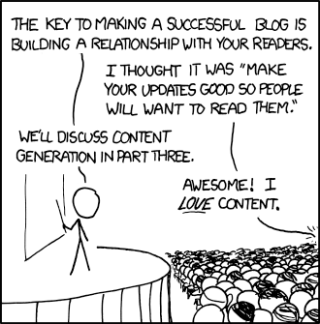A Miniature Rhetorical Analysis on Project for Awesome
Project for Awesome, created by the infamous Vlog Brothers, is a Youtube video competition/charity drive intent on “decreasing world suck.” The gist of Project for Awesome is that people upload videos to Youtube that advocate some sort of charitable organization, and viewers watch these videos and vote on their favorite ones. During this time, an IndieGoGo fundraiser page is available for viewers to make donations to Project for Awesome. The five (or ten in 2012) videos with the most votes then split the donations amassed by all of the viewers. The 2012 Project for Awesome alone raised $483,296.
For my final project in my Comp 2 class, I was assigned to investigate a case of using digital media such as social media or online videos to support some sort of cause or community organization. I chose to perform a case study on Project for Awesome, or more specifically, the winners of the 2012 Project for Awesome. By investigating these winning videos and identifying the characteristics which led them to gain the most votes from their viewers, I can glean insight regarding writing or media techniques to apply to my own work. It would be especially relevant if I ever end up making Youtube videos.
Here’s a list of the videos/organizations that won the 2012 Project for Awesome:
- Office of Letters and Light
- Not Forgotten
- Wildlife Waystation
- Alzheimer’s Society
- Harry Potter Alliance
- Save the Children
- BGSU Dance Marathon
- Uncultured Project
- Techo
- Love146
Now for the rhetorical analysis. Here’s the agenda: (1) Identify the author and the intended target audience (2) Determine the intended purpose (3) Point out examples of ethos, pathos, and logos being used (4) Evaluate its effectiveness in achieving its intended purpose.
So what is the author of the winning videos? Obviously, there are many of them. Some examples would include Charlie McDonnell (AKA CharlieIsSoCoolLike), Gunnarolla, and the Harry Potter Alliance. The intended audience of these videos would be (again, pretty obviously) the entire Youtube viewership, which could be a combination of all sorts of different people (here is a page of the Youtube viewer demographics, courtesy of Youtube).
Next, what is the purpose of these videos? Well, as we’ve previously established, the videos are designed to advocate a charitable organization of some sort and to gain votes from viewers in order to win a share of the donations for the charity.
Now here’s where it gets fun. What are some examples of ethos, pathos, and logos within these videos? With all of the different videos that won just in 2012 alone, I have seen examples of all sorts of rhetorical strategies. For ethos, the most common strategy was charisma, using charm or humor to draw the audience in. Also, the fact that a lot of these video makers already had massive followings prior to Project for Awesome would have been helpful, since many of the viewers would have already been familiar with or were fond of the video makers. Some of the videos included firsthand experience from the speaker. One example would be Charlie McDonnell who, in his video advocating the Alzheimer’s Society, described his experience of having a grandfather who had Alzheimer’s disease and eventually passed away as a result. This one was particularly effective for me as it showed that Charlie McDonnell had a strong reason to be advocating the organization he/she was supporting.
These videos also had numerous instances of pathos. Since most if not all charities are established to solve some sort of world problem, it is easy to appeal to the audience’s emotion by describing in detail the problem they seek to solve. Appealing to emotion can also be easily achieved simply through language. One video supporting the Wildlife Waystation was effective in using pathos by making me feel responsible about helping their animal sanctuary since they are primarily funded by donations. The video said that it was up to me to help these animals. I immediately felt an emotional response. I didn’t want to feel the guilt of seeing those animals suffer, so I felt compelled to donate and support them. Now that’s pathos.
Finally, we have logos. Logos is probably the most upfront of the rhetorical strategies, and that makes it effective when used correctly. The most common use of logos I noticed in these videos was the use of statistics and general logical statements. The Harry Potter Alliance video showed an impressive use of statistics to inform the viewer of how many members they have amassed, how much money they have raised, how much supplies they have donated, and other useful information. While doing so, the video remained organized and engaging.
Overall, these videos were fairly effective. By using a mix of the three different rhetorical strategies of ethos, pathos, and logos, they got their points across and compelled me to take action as well. I saw instances of authority through firsthand experience, charismatic presentation, appeal to emotion and morality, and factual data and evidence. In addition, what I believe to be effective about Project for Awesome is that even though it is over for this year, the videos are still online and can still raise awareness about these various charities and nonprofit organizations. I hope to gain even more insight into the effectiveness of Project for Awesome through my digital activism project.




